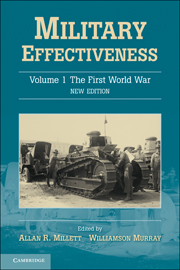Book contents
- Frontmatter
- Contents
- List of Contributors
- Preface to the First Edition
- Introduction: Military Effectiveness Twenty Years After
- Maps
- 1 The Effectiveness of Military Organization
- 2 Britain in the First World War
- 3 The Dynamics of Necessity: German Military Policy during the First World War
- 4 American Military Effectiveness in the First World War
- 5 Italy during the First World War
- 6 The French Army in the First World War
- 7 Japan, 1914–18
- 8 Imperial Russia's Forces at War
- 9 Military Effectiveness in the First World War
- Index
4 - American Military Effectiveness in the First World War
Published online by Cambridge University Press: 05 June 2012
- Frontmatter
- Contents
- List of Contributors
- Preface to the First Edition
- Introduction: Military Effectiveness Twenty Years After
- Maps
- 1 The Effectiveness of Military Organization
- 2 Britain in the First World War
- 3 The Dynamics of Necessity: German Military Policy during the First World War
- 4 American Military Effectiveness in the First World War
- 5 Italy during the First World War
- 6 The French Army in the First World War
- 7 Japan, 1914–18
- 8 Imperial Russia's Forces at War
- 9 Military Effectiveness in the First World War
- Index
Summary
Introduction
During the First World War the US Army grew from a constabulary force of about 100,000 professionals to a conscript army of four million. The Navy changed in an equally rapid fashion, from a force built around a few powerful battleships to one consisting of hundreds of smaller craft for combatting submarines. The American military effort was immense, and in some respects unique – supporting a 2 million man expeditionary force 3,000 miles from home, fighting a war with allies for the first time since 1783, and attempting to mobilize the entire industrial economy to prosecute the war. To a considerable extent traditional practices, in Russell Weigley's terms ‘the American way of war,’ shaped wartime performance at all levels – political, strategic, operational, and tactical. American effectiveness in each of these spheres depended on how readily the military adapted its past experience to the demands of the world war situation. A few key issues, including how to use US combat troops overseas, shipping shortages, and the difficulties of industrial mobilization, had an impact on military effectiveness at all levels. Perhaps the most significant limitation on American effectiveness, especially operationally and tactically, was the short time the United States was an active belligerent. The Americans, despite a massive war effort, had little opportunity, because they had so little time, to learn from their experience and improve effectiveness.
- Type
- Chapter
- Information
- Military Effectiveness , pp. 116 - 156Publisher: Cambridge University PressPrint publication year: 2010

